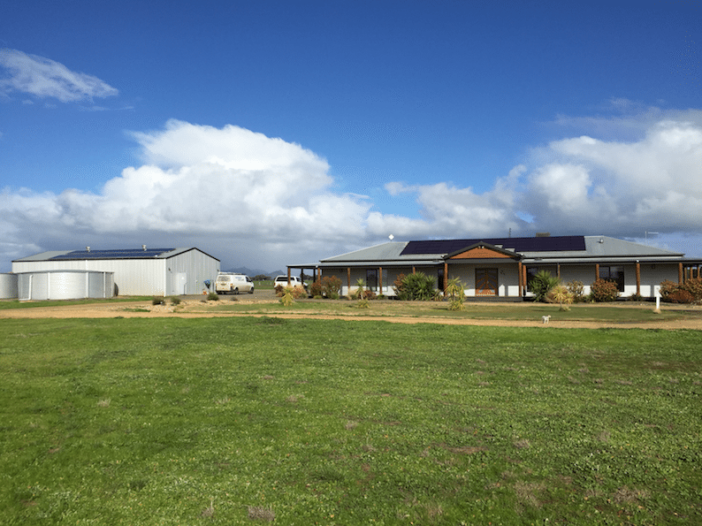
When an agronomist and his family bought a cleverly laid out, eco-designed family home, there was an off-grid bonus as well as a number of other energy efficiency measures, all rolled into a 90 acre package that comfortably manages the harsher elements of the Australian climate.
While most people dream of building a carbon neutral home from scratch, the Severin family were lucky enough to walk straight into an established family pad near Horsham in western Victoria.

Designed by a local award winning eco-builder Justin Lane, their home is well prepared for Australian summers and is the perfect setting for Simon Severin, who works as an agronomist, assisting local farmers with cropping decisions, including nutrition and pest management strategies.
“We’re weren’t really looking for an off-grid property, but this home was the perfect fit for us and we considered the standalone system a nice bonus,” says Simon who bought the property with wife Justine, who is a public relations officer. “Who wouldn’t enjoy not having to pay another power bill?”
“The decision to go off-grid was made by the original owners and was driven by the cost of connecting grid power – we’re 12km south east of Horsham – plus the rising cost of electricity.”

“They installed a 3kW system which complimented the house design. It has double glazed windows and is heavily insulated. Verandas and outdoor area mean there is as 50 squares under the roof but only 26 living area.”
“This keeps the house cool in summer and warm in winter. A wood heater heats the entire house and an evaporative cooler is ample to keep the house cool over summer.”
As well as the inherent design of the home saving them money, the Severin’s also have a solar hot water system that is gas backed and an all-gas oven and stove top.

However, it became clear that the 3kW system wasn’t going to be enough to support all the requirements of the family of five, including children Bonnie, 22, Emily, 14 and Ben, 12.
“In July we upgraded our system to 12kW, so there’s ample power now,” explains Simon. “The batteries are always charged to 100% at sunset, no matter how much power we use during the day, even during the colder and cloudier months.”
“The battery set is 660 amp hour, 48 volt, 15 kWh and we have an auto-start Honda 8kva generator, which was set up to run when the batteries are at 50% state of charge.”

“With the old system the generator wasn’t used at all from October to March, but would go for about 2 hours each day at other times. Since the upgrade it hasn’t been needed at all.”
Simon says the family have adapted their lifestyle only slightly since moving into the house in June 2014, but have had no issues at all since the upgrade in July 2015.
“The only electrical appliance we don’t use is a clothes dryer, but we didn’t have one even when we lived on-grid.”
“In order to further improve battery life we have installed LED globes throughout the entire house which has reduced night consumption from lighting by 3kWh. They range from 4W to 11W per globe and are brighter than the old halogen globes.”

“Rainwater supplies the house and there is ample catchment from the shed and house with 120,000 litres of storage in tanks. Wastewater is recycled to the garden and surrounding trees.”
Simon says the old 3kW system consisted of 50 x 60 Watt panels which are still used, but with an added 14 x 260 watt panels equalling 3.64kW for a total of 6.64kw on the house roof. The extra power comes from 24 x 260 Watt panels (6.24kW) on the shed roof for a grand total of 12.88kW.
“With the old system, the panels couldn’t keep up with the battery capacity. Now the panels charge batteries quickly and, with the advancement of battery technology, we will replace the existing ones with double or more capacity. This will match up the catchment and storage capacity.”
The specs: The Severin’s system consists of 50 x 60 watt panels with an additional 14 x 260 watt panels totalling 12.88kW. There are 2 x 5kw SMA inverters, 1 x 5kw sunny island, 660 amp hour gel batteries and an auto-start back up generator. The upgrade was installed by Lachlan Hick from Natimuk Solar



